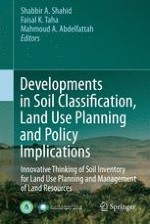2013 | OriginalPaper | Chapter
35. Participatory Soil and Land Evaluation Mapping: An Alternative Approach to Improve Soil and Land Evaluation Information for Decision Makers
Authors : Ivan Luiz Z. Bacic, Juniele R. Pivetta, Roberta P. Martins
Published in: Developments in Soil Classification, Land Use Planning and Policy Implications
Publisher: Springer Netherlands
Activate our intelligent search to find suitable subject content or patents.
Select sections of text to find matching patents with Artificial Intelligence. powered by
Select sections of text to find additional relevant content using AI-assisted search. powered by
